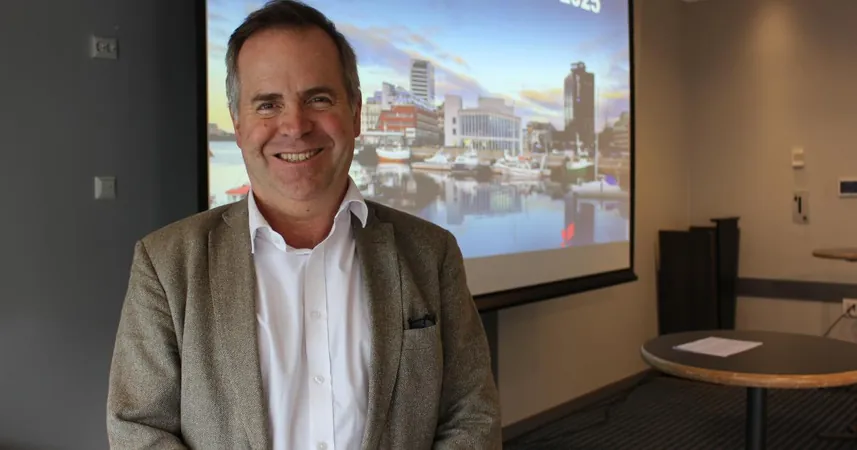
The Growing Threat of Satellite Pollution: Experts Warn of Light and Environmental Hazards
2025-03-28
Author: John Tan
Introduction
In a concerning revelation, Dr. Michael Byers, a prominent professor of Global Politics and International Law at the University of British Columbia, has expressed alarm over the increasing number of satellites orbiting Earth and the environmental implications of this trend. Speaking at the High North Dialogue conference in Bodø, Northern Norway, he emphasized the urgent need for a sustainable and responsible approach to space development.
"As we venture into space, we are impacting an entire earth-space environmental system," Dr. Byers stated. "Everything we launch adds more stress to that system. We must act wisely to ensure that our use of outer space is safe and environmentally sustainable."
Light Pollution Concerns
One of the most pressing concerns Dr. Byers highlighted was the phenomenon of light pollution caused by satellites. Traditionally associated with artificial lighting on land, light pollution is now emerging as a significant issue from above, threatening both our connection to the night sky and the delicate balance of the ecosystem. Solar-powered satellites reflect sunlight even when it is dark on Earth, leading to light levels that can overshadow stars and hinder stargazing experiences for generations to come.
The degradation of dark skies is not just an aesthetic issue; it has profound implications for wildlife, notably migratory birds, which rely on natural light patterns for navigation. Indigenous cultures that have revered the night sky are also at risk of losing a vital aspect of their heritage. Alarmingly, Dr. Byers pointed out that there are currently no regulations targeting the mitigation of light pollution from satellites.
Impact on Astronomy
Astronomers, too, face challenges due to the burgeoning number of satellites. The streaks created by these fast-moving objects can compromise the integrity of astronomical images and obstruct views of distant cosmic phenomena. Additionally, satellite radio signals can interfere with astronomers' instruments, exacerbating their concerns about the sustainability of astronomical research in the face of commercialization and corporate interests.
Corporate Influence and Responsibilities
SpaceX, with an estimated 8,000 satellites in orbit, has been at the forefront of this debate. Dr. Byers noted that while the company has taken some steps to minimize its light pollution, such as experimenting with alternate coatings and visors for its satellites, plans to deploy hundreds of thousands of additional satellites could further exacerbate the problem. The growing reliance on technology companies for satellite-based services raises questions about the protection of our night skies and cultural heritage.
Space Debris and Environmental Risks
The issue of space debris is equally concerning. As satellites reach the end of their operational lifespans, they re-enter the Earth’s atmosphere, disintegrating into countless particles. Dr. Byers warned that this process might introduce unprecedented levels of aluminum and other materials into the upper atmosphere, potentially threatening the ozone layer — a risk that humanity has only recently started to mitigate under international agreements like the Montreal Protocol.
Moreover, the absence of effective regulations surrounding the disposal of space debris raises serious questions about the environmental impact of our explorations. Dr. Byers suggests that a new approach might be to design satellites for controlled descent into remote ocean areas rather than burning up in the atmosphere — a strategy that still poses environmental risks but could be less harmful.
Call to Action
As space activities expand, Dr. Byers urges governments and space agencies worldwide to take a proactive stance toward regulation and the creation of sustainable practices in outer space. “We cannot let this industry operate without regard for its impacts,” he warns, stressing the importance of governance in preserving both our cosmic and terrestrial environments.
Conclusion
In conclusion, the future of our night skies hangs in the balance, and experts like Dr. Byers are calling for immediate action to secure a sustainable future as we explore the final frontier. Without regulatory measures, we risk losing not only our connection to the universe but also a vital segment of our cultural heritage and the health of our planet.

 Brasil (PT)
Brasil (PT)
 Canada (EN)
Canada (EN)
 Chile (ES)
Chile (ES)
 Česko (CS)
Česko (CS)
 대한민국 (KO)
대한민국 (KO)
 España (ES)
España (ES)
 France (FR)
France (FR)
 Hong Kong (EN)
Hong Kong (EN)
 Italia (IT)
Italia (IT)
 日本 (JA)
日本 (JA)
 Magyarország (HU)
Magyarország (HU)
 Norge (NO)
Norge (NO)
 Polska (PL)
Polska (PL)
 Schweiz (DE)
Schweiz (DE)
 Singapore (EN)
Singapore (EN)
 Sverige (SV)
Sverige (SV)
 Suomi (FI)
Suomi (FI)
 Türkiye (TR)
Türkiye (TR)
 الإمارات العربية المتحدة (AR)
الإمارات العربية المتحدة (AR)